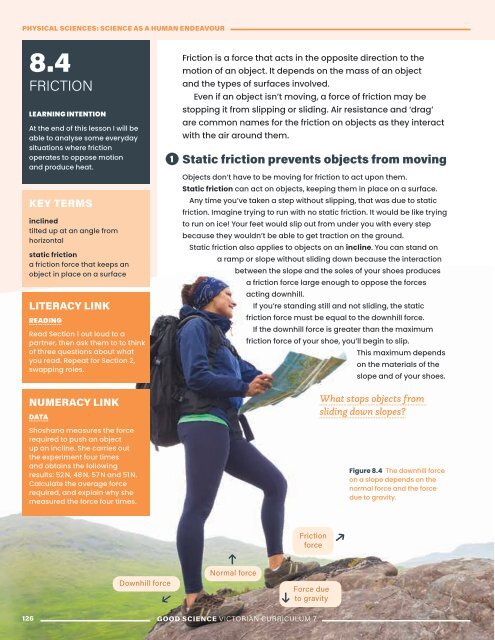Good Science Victorian Curriculum Year 7
Digital sample of Matilda's newest publication, Good Science Victorian Curriculum Year, authored by Emma Craven and Aaron Elias. For more information visit www.matildaeducation.com.au or email Katrina Tucker, katrinatucker@matildaed.com.au
Digital sample of Matilda's newest publication, Good Science Victorian Curriculum Year, authored by Emma Craven and Aaron Elias. For more information visit www.matildaeducation.com.au or email Katrina Tucker, katrinatucker@matildaed.com.au
Create successful ePaper yourself
Turn your PDF publications into a flip-book with our unique Google optimized e-Paper software.
PHYSICAL SCIENCES: SCIENCE AS A HUMAN ENDEAVOUR<br />
8.4<br />
FRICTION<br />
LEARNING INTENTION<br />
At the end of this lesson I will be<br />
able to analyse some everyday<br />
situations where friction<br />
operates to oppose motion<br />
and produce heat.<br />
KEY TERMS<br />
inclined<br />
tilted up at an angle from<br />
horizontal<br />
static friction<br />
a friction force that keeps an<br />
object in place on a surface<br />
LITERACY LINK<br />
READING<br />
Read Section 1 out loud to a<br />
partner, then ask them to to think<br />
of three questions about what<br />
you read. Repeat for Section 2,<br />
swapping roles.<br />
NUMERACY LINK<br />
DATA<br />
Shoshana measures the force<br />
required to push an object<br />
up an incline. She carries out<br />
the experiment four times<br />
and obtains the following<br />
results: 52 N, 48 N, 57 N and 51 N.<br />
Calculate the average force<br />
required, and explain why she<br />
measured the force four times.<br />
1<br />
Friction is a force that acts in the opposite direction to the<br />
motion of an object. It depends on the mass of an object<br />
and the types of surfaces involved.<br />
Even if an object isn’t moving, a force of friction may be<br />
stopping it from slipping or sliding. Air resistance and ‘drag’<br />
are common names for the friction on objects as they interact<br />
with the air around them.<br />
Static friction prevents objects from moving<br />
Objects don’t have to be moving for friction to act upon them.<br />
Static friction can act on objects, keeping them in place on a surface.<br />
Any time you’ve taken a step without slipping, that was due to static<br />
friction. Imagine trying to run with no static friction. It would be like trying<br />
to run on ice! Your feet would slip out from under you with every step<br />
because they wouldn’t be able to get traction on the ground.<br />
Static friction also applies to objects on an incline. You can stand on<br />
a ramp or slope without sliding down because the interaction<br />
between the slope and the soles of your shoes produces<br />
a friction force large enough to oppose the forces<br />
acting downhill.<br />
If you’re standing still and not sliding, the static<br />
friction force must be equal to the downhill force.<br />
If the downhill force is greater than the maximum<br />
friction force of your shoe, you’ll begin to slip.<br />
This maximum depends<br />
on the materials of the<br />
slope and of your shoes.<br />
What stops objects from<br />
sliding down slopes?<br />
Figure 8.4 The downhill force<br />
on a slope depends on the<br />
normal force and the force<br />
due to gravity.<br />
Friction<br />
force<br />
Downhill force<br />
Normal force<br />
Force due<br />
to gravity<br />
126<br />
GOOD SCIENCE VICTORIAN CURRICULUM 7


















